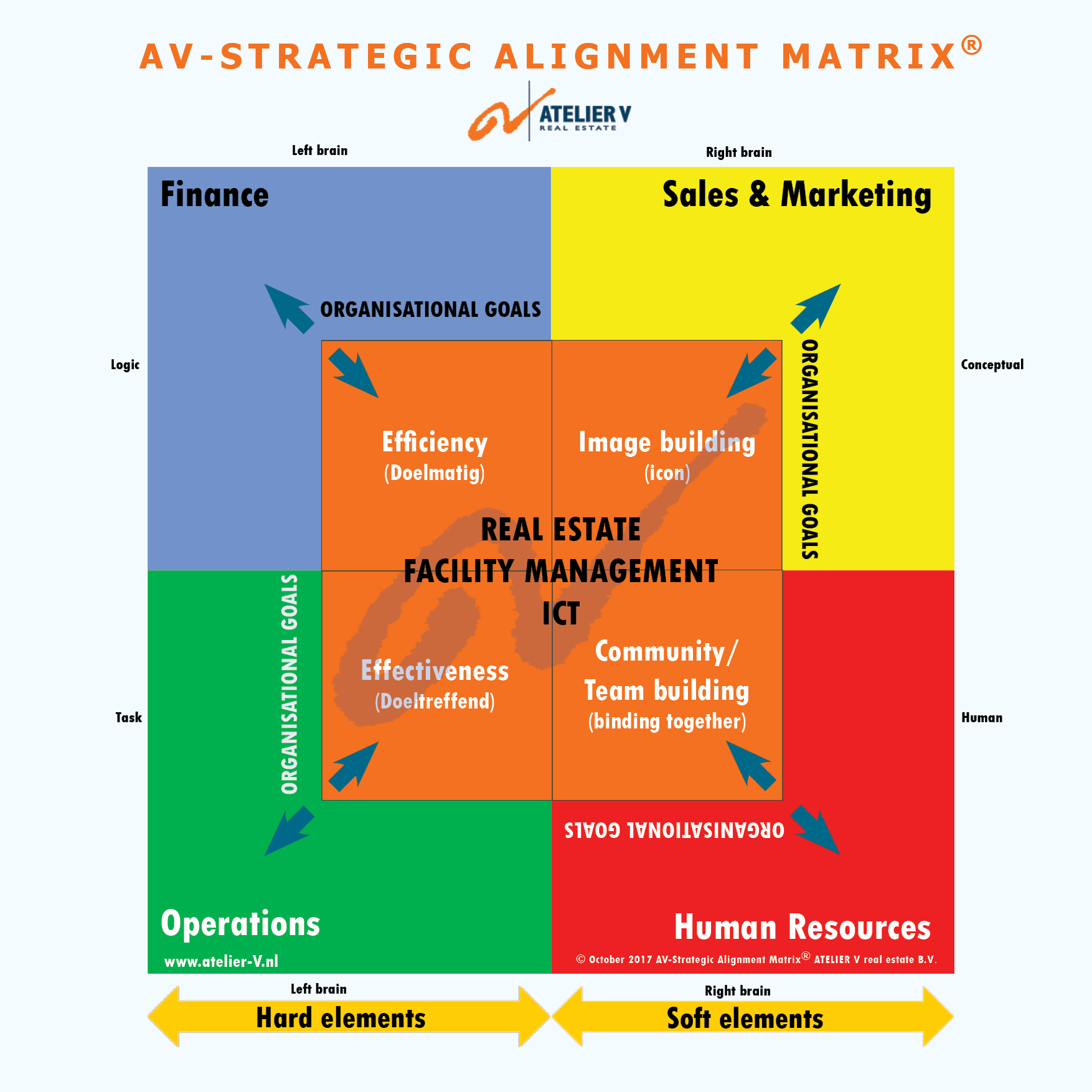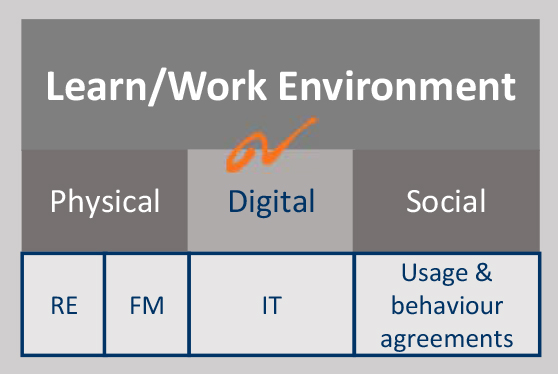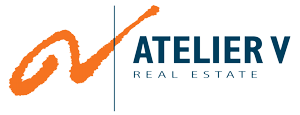By looking at a learn/work environment through a Finance, Operations, Sales & Marketing and Human Resources lens, the relationship with the organisational goals is more visible to create an adequate workplace strategy.

Dynamic strategy alignment
This gives both the hard economic and the soft social aspects a place within the context of how an organisation wants to stand in society and be recognized by the relevant stakeholders. It connects organisational goals with the implementation of how the learn/work environment can support them.
Using our Strategic Alignment Matrix research technique is one of the first steps in our client analysis to identify vision, strategy, culture, structure, and direction to determine the desired outcome.
A common definition of workplace strategy is the dynamic alignment of an organisation’s work patterns with the work environment to enable peak performance and reduce costs. It is a balancing act to deliver measurable competitive advantage. A Strategic Accommodation Roadmap is required to navigate and bring into a harmony that differs or could differ.
A Strategic Accommodation Roadmap is a dynamic accommodation planning tool just like there are tools for budgeting finances. It contains scenarios for the future (Change, Improve, Transform, Create) tailored to the specific organisational context. The Strategic Accommodation Roadmap can be described as the plan to translate organisational goals and ambitions into accommodation management objectives and how this contributes to (public) demands and needs.
Management has often a sense of having no grip on the learn/work environment. Where does this feeling come from? Too little measured or are the wrong aspects measured? Does more grip means more measuring or is it mainly about figuring out the relevant issues that contribute to the organisation goals? Why are we doing something? What are the contributions? What do we want to accomplish? How can we achieve this?
How contributes the environment to the organisational goals?
The learn/work environment is multi-layered and consists of the physical, digital and social environment. The Real Estate (RE) and Facility Management (FM) departments are in charge of the physical environment and the Information Technology (IT) department of the digital environment. The social environment is the domain of the Human Resources department. The learn/work environment does not stand alone but has a strong influence on all management focus areas. The challenge is that the actors involved have different perspectives and interests.
An integrated learn/work environment ecosystem of Bricks, Bytes and Behaviour to create Places that matter and work instead of just workplaces.

Focusing on the parts of a whole may teach us a lot about the architecture of the components, but only to the extent where we are able to relate each individual part to the whole that it makes up. The challenge cannot successfully be addressed by experts or authorities alone, but only with the engagement of the actors themselves. It requires an integrated multi-stakeholder approach.
“The stereotype of accommodation being an operational headache needs some revision. It can be a strategic opportunity as well.” (René Stevens)
Interventions in the learn/work environment are usually characterized by their ad hoc nature, while they are in fact part of the integrated organisational strategy. The vision and mission of an organisation are translated into ambitions, goals and a strategy to achieve them. Raising the question “Is the learn/work environment an operational headache or a strategic opportunity?”, set us off on an ongoing discovery journey.
Insight leads to value creation
Since 2003, the AV-Strategic Alignment Matrix® (SAM) method has been developed into what it is today. It provides the connecting link between organisational goals on the one hand and learn/work environment performance on the other. It forms the business foundation for strategic and dynamic management of the learn/work environment. This is the entire cohesive process of accommodation strategy, policy, implementation and evaluation.
The SAM method deals with the complexity of and helps to continually align and attune the learn/work environment with the (changing) organisational objectives and the health and well-being of the users. It forms the input for business value cases of new projects and also a framework to evaluate completed projects and to monitor the performance of the existing learn/work environment. Awareness of this process and recognizing interdependence can lead to better processes.
An applied SAM is always organisation-specific although in its self a generic model. The SAM model provides insight and understanding of a large amount of policy information with derived relevant success indicators for required learn/work environment performance. Moreover, it is a means of conducting a dialogue about the mutual coordination of Real Estate with the other business assets Facility Management and Information Technology, which creates a focus on the intended (integrated) value creation.
It helps to formulate the implications of strategic choices more clearly and to communicate with relevant (internal) stakeholders. The SAM matrix is a simple and flexible framework. It helps balance value creation with the learn/work environment and the costs, risks and time involved in initiating, implementing and operating it.
A completed SAM matrix includes the ranking of the performance indicators and forms the basis for systematic evaluation, monitoring and, if necessary, adjustment or interventions in the learn/work environment. This makes continuous improvement possible and forms a cornerstone for a learning organisation.

The inventory of the four management focus areas and the resulting ‘quick wins’ are parts of the bigger picture. Parts that are organised in an analytical way. Like the displayed cogwheels of a machine. To make the machine (read organisation) run smoother, one can tinker with the cogwheels and/or the ‘machine’ can be put in another accommodation. But the whole is more than the sum of its parts. An organisation is more than a collection of people who perform certain tasks. There is also an organisational culture of norms and values with symbols and rituals. Man is not a machine and neither is an organisation. People are not means of production, despite the term ‘human resources’.
The quick wins are partly interventions in certain cogs, but partly also incentives to adjust the culture in order to make the whole, organisation, run better. And maybe that’s enough for the foreseeable future.

Accommodation, block or accelerator?
The SAM model can be used to develop an integrated learn/work environment strategy that contributes to the achievement of organisational goals (Strategic Accommodation Roadmap). It has been developed in such a way that it is modular and always custom-made for an organisation.
The AV-Strategic Alignment Matrix provides a framework to identify the relevant matters that add value to the organisational objectives, the so-called value drivers or success determining factors. Once these are known, the right measures of success can be developed and made SMARTI (Specific, Measurable, Acceptable, Realistic, Time-bound and Inspiring). This enhances alignment, attunement and balance of the learn/work environment with organisational objectives.
Providing insight for targeted interventions in the current learn/work environment. and evaluating efforts, which will give feedback on the strategy. It enables action-oriented management and accountability.
The learn/work environment is a complex integrated ecosystem where cause and effect relationships are difficult to isolate. The power of the SAM model is that it is robust, fast and adaptable to make connections between the hard and the soft learn/work environment factors and the business process of value creation.
Comparing multiple data reveals relationships that were previously hidden. It connects the mind with the heart. A responsible analysis of all costs and benefits, both in the field of Real Estate, Facility Management and Information Technology. It forms essential input to write a Value case through the lens of a well-functioning organisation and the well-being of its employees.
The effects of cost reduction or realization of asset value are usually difficult to replicate; however, the so-called soft results of culture and process changes can be continuously enhanced and improved. The ‘soft’ measures of human engagement, as used in the marketing and communications industry, are in most cases more relevant than the necessary ‘hard’ absolute measures of cost and square footage. Especially when the soft relative indicators of performance are monitored over a longer period of time.
Measure what matters
The SAM method sorts the formulated strategy to achieve the organisation’s goals to the management focus areas: Finance, Operations, Sales & Marketing and Human Resources. Each quadrant looks at how the learn/work environment can contribute to these (sub)goals. The required performances of the learn/work environment asset are made explicit so that they can be measured, tracked and managed.
The Strategic Alignment Matrix consists of two vertical axes, a ‘hard’ axis with economic goals, Finance – Operations (What can the building do?), and a ‘soft’ axis with social goals, Sales & Marketing – Human Resources (What does the building do with you as a person?). The two axes are connected with each other like communicating vessels. It is important to find for your own organisation the optimal balance between both axes. Too much emphasis on the ‘hard’ economic axis is at the expense of the social aspects on the ‘soft’ axis.
About 70-80% of the budget consists of employee costs. Only 8-12% is about accommodation costs. It is the employees who take care of the turnover. Would you rather like to get the optimum out of the accommodation or from the potential of the employees? It is obvious that the main focus should be on achieving an effective learn/work environment instead of (only) cost efficiency.
In the figure, the aspects from the McKinsey 7S model and the Balanced Scorecard (BSC) are mentioned in order to create added value. The SAM methodology sorts the formulated strategy text to achieve the organisational goals into the four strategic management focus areas. These text fragments are then labelled according to 20 generic ambitions to add value with Real Estate (RE), Facility Management (FM) and Information Technology (IT). For each quadrant, it is examined how the learn/work environment contributes to these (sub) goals. The whole, value proposition (7S-1 Strategy), is more than the sum of its parts (7S-2 to 7S-6).


Subsequently, in the four fields: Efficiency, Effectiveness, Image-building and Community/Team-building, the accommodation performance is stated that contribute to the achievement of the organisational goals as listed in the four management focus areas. The required performance of the learn/work environment asset (Real Estate, Facility Management and Information Technology) is thus made explicit. This enables a learning process of transparent objective monitoring, adaptation and communication of feedback instead of identifying problems and allocating errors.
The appointed accommodation performances in the 4 orange fields, Efficiency, Effectiveness, Image-building and Community/Team-building, form the input to an adequate learn/work environment strategy, brief or benchmark study. The big advantage is that it remains clear to what organisational purpose the accommodation performances should contribute.
This provides consistency with the organisational goals and mutual coordination between the Real Estate, Facility Management and Information Technology assets. It aligns and harmonizes the learn/work environment with the organisational strategic objectives.
For each, the Department of Real Estate, Facility Management and Information Technology an A3 Strategic Management Canvas or Accommodation Roadmap (RE-GPS) is made with the required ambition, competencies and activities. Each indicates how they can contribute to the objectives of the four management fields. For this, we use the eight constraints of a project, Scope, Time, Risk, Experience, Resources, Information, Cost and Quality (STRERICQ). These aspects are made SMARTI, coordinated and integrated into one approach because they are all inseparable parts of the whole learn/work environment.
- Scope/Strategy – What exactly is the desired outcome (performance requirements: how good and how many, where, when, for whom and how often)? (Effectiveness)
- Time – By when, for how long, should the outcome be delivered? (Efficiency, Evidence)
- Risk – What can go wrong, and what can be done about it to mitigate or avoid it? (Evidence)
- Experience – How satisfied should the users be? How closely matches the outcome for people’s engagement? Are we able (and willing) to deliver to the employee’s needs? (Engagement)
- Resources – Who and What is Where required to do the work? Which capacity and competence are required for managing the required objectives and expectations? (Efficiency, Evidence)
- Information – What are the relevant measurements to report for informed decision-making? (Evidence)
- Cost – How much money is available to achieve the outcome? Price is what you pay, value is what you get. (Efficiency)
- Quality [1] – How closely matches the outcome with the objectives and expectations (Functional, Esthetical, Technical)? (Effectiveness)
[1] Quality is understood to mean: geographical location, floor area and functional, aesthetic and technical performance of the accommodation. Quality and quantity are actually two sides of the same coin. This is e.g. shown in the trend towards less floor area that is more intensively used but with more quality (fit for purpose).
In order to actually achieve the desired end result, it is essential to describe the accommodation objectives clearly and measurably in the specific organisational context within the available budget and time frame. This makes it possible to determine whether the quantitative targets have been achieved and whether the desired behavioural change has occurred. Communication with the users about the measured results and their own subjective experiences is crucial. After all, it is about optimally facilitating the potential of the employees/students.
The point of attention is the difference in the planning horizon of the real estate strategy (40 years and even longer) and the corporate strategy (about 5 years). This brings a challenge of how to incorporate a longer-term commitment in real estate within a shorter-term organisational strategic view. Different parts of a building change at different rates to follow constantly changing user requirements. There are 8 layers of change.
“Not everything that counts can be counted, and not everything that can be counted, counts.”
(Albert Einstein)
Keep in mind Albert Einstein’s quote: “Not everything that counts can be counted, and not everything that can be counted, counts.” The performance of the learn/work environment eco-system is best benchmarked against relevant components and ambitions/goals within the own organisation instead of (only) with external (comparable) organisations.
The management is thus able to dynamically steer the accommodation process based on the integral organisational strategy and the objectives of the academic departments and therefore retains control. This is desperately needed because organisations, work processes and therefore the learn/work environment are constantly subject to change under the influence of all kinds of economic, technological and social developments. See also the articles Strategic accommodation and The Strategic building unravelled.
Make real estate strategy SMART
The AV-Strategic Alignment Matrix® (SAM) is in fact a lens through which to look at the organisational strategy. With SAM you literally zoom in on the learn/work environment in all its facets. SAM makes the connection between the hard and the soft aspects of business operations with accommodation visible and measurable. It uses SMART performance indicators by means of the REN-method. Result agreements on the asset mix (Real Estate, Facility Management and Information Technology) can now be directly linked to one or more of the organisation’s ambitions/goals.
SAM provides the framework and context to manage a learn/work environment evidence-based, according to the eight constraints of a project, Scope, Time, Resources, Experience, Risk, Information, Cost, Quality (STRERICQ). This helps in making choices for targeted interventions in the current learn/work environment. It makes users and decision-makers more aware of the impact of the accommodation on the organisational strategy. A strategic learn/work environment is therefore within reach and contributes to a competitive advantage.
To belong to the group of winners, an organisation should regularly evaluate its learn/work environment strategy with a 360° feedback survey. This provides strategic agility through continuous improvement using the Deming cycle of Plan-Do-Check-Act (PDCA). The success of an organisation is usually not determined by the strength of a strategy, but by the extent to which the strategy is implemented.

SAM method as building block
In the development of the Office Styles®, a classification of office organisations based on corporate style, management style and culture (vision and values), the AV-Strategic Alignment Matrix® (SAM), in addition, the Motivaction Mentality Model®, was one of the pillars.
How employees and the organisation where they are employed, relate to each other becomes clear with the help of the Prosperity Model®. For an application of the Strategic Alignment Matrix see also the Real Estate General Performance Survey (RE-GPS) with the Dutch webinar “Inspiring Workplaces that promote value creation”.
Benefits of the Strategic Alignment Matrix
- Focus on intended (integrated) value creation for the organisation and people.
- Your own organisation’s ambitions are clearly mapped out for each management field of attention and prioritized.
- Involvement of stakeholders guaranteed.
- Coherence between strategic ambitions and the assets mix of Real Estate, Facility Management and Information Technology.
- Promotes dialogue about mutual coordination between Real Estate, Facility Management, Information Technology and Human Resources departments.
- Quick insights into status if performances are achieved and/or adjustment is required.
- Action-oriented management and accountability for strategic agility of the learn/work environment.
- Aligns and synchronizes the learn/work environment with the organisational strategic objectives.
